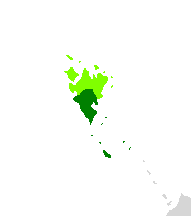South Ayeli
Imperial State of Ayeli | |
|---|---|
| Motto: Loyalty to the Emperor and to the People | |
 Map of Ayeli, with the territory controlled by South Ayeli in dark green and the territory it claims in light green | |
| Capital and | Hamuilaqta |
| Official languages | Cherokee |
| Ethnic groups (2015) | 83.4% Wutagawi 12.5% Runakuna 1.3% Belfrasian 0.9% Mutuli 2.4% Other |
| Demonym(s) | Wutagawi |
| Government | republic |
• Prime Minister | Diwadi Gaduna |
| Legislature | Imperial Parliament |
| Establishment | |
• Elections of 2019 | Mars 2019 |
| Area | |
• Total | 27,000 km2 (10,000 sq mi) |
| Population | |
• Estimate | Between 2 to 4 millions |
| GDP (nominal) | estimate |
• Total | 2 billions USD |
• Per capita | 250 USD |
| Currency | Unosda (AYU) |
| Date format | dd.mm.yyyy |
| Driving side | right |
| Internet TLD | .kk |
South Ayeli, officialy the Sovereign State of Ayeli is a country that emerged from the aftermath of the 2018 Eruption of Mount Nunakun and the political crisis that followed with the disparition of the Imperial Family and of most of the government. Since its creation, it claims to be the sole legitimate authority over Ayeli, a claim contested by North Ayeli, the "Democratic Republic of Ayeli". The first country to recognize South Ayeli as the sole legitimate authority over the island was the Mutul, then followed by X nations, including TBD and TBD. Its capital and largest city is Hamuilaqta.
Because of the political instability that plague the region since 2018, South Ayeli lost a major part of its economic capacity both from the earthquake and the political crisis. Similarily, it is for now impossible to say the exact population living in the State. The newly elected government has started multiple reconstruction and agricultural programs to accelerate the recovery of Ayeli, It nonetheless maintain an aggressive rethoric toward North Ayeli, with the de-facto, unrecognized, border between the two being heavily millitarized. This cold war is preventing the return of Ayeli to its pre-earthquake living standards.
History
Geography
Politics
Economy
Ayeli has a predominantly free market economy now that it is no longer controlled by the various imperial agencies. Lack of trustworthy numbers means that most studies estimate the current GDP of South Ayeli to be half of that of the Imperial State. It's currency is the Unosda. Even before the Earthquake, Ayeli was the poorest country of the Kayamuca Sea. It is impossible to say how many Ayelian citizens currently reside in South Ayeli because of the lack of exact numbers on the Earthquake's deathtoll and the subsequents migrations, both from or into North Ayeli and to other countries like Mutul and Belfras.
Today, the most important trade partner of South Ayeli is the Mutul, which is both its main import and export partner. It also receive important donations and aids from the Divine Throne, as well as low-interests loans from Mutuleses banks. These are the main sources of capitals for the South Ayelian government, who then re-invest it into its reconstruction programs and reformed military.
